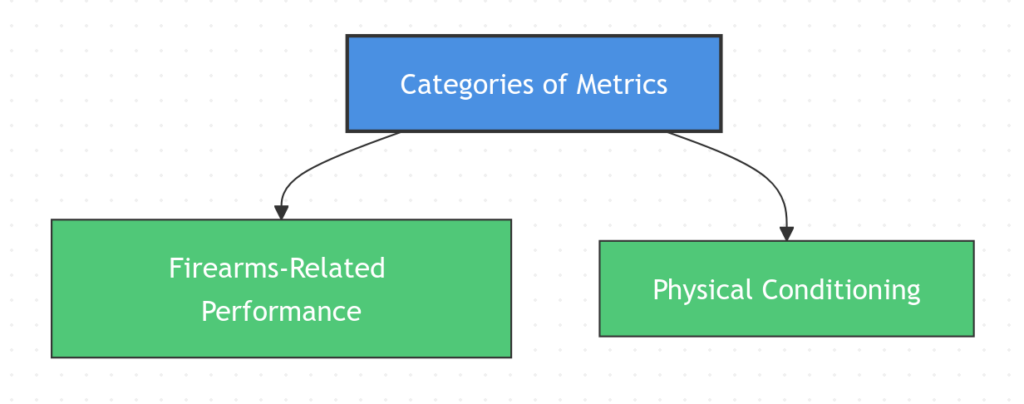In ABA Intl’s methodology, metrics are not optional — they are a structural pillar. As one of the three elements of the TMM Triad (Technique, Metrics, and Method), metrics provide the objective foundation upon which all technical and tactical development is built. Technique defines how you perform. Method determines how you train. But only metrics reveal, with cold precision, where you currently stand and where you must go.
Without metrics, performance becomes guesswork. With metrics, performance becomes measurable, comparable, and improvable.

1. Why Metrics Matter
Metrics transform firearms training and combatives from something intuitive into something scientifically trackable. They replace the illusion of progress with data. They allow instructors to diagnose weaknesses, identify trends, and prescribe training with accuracy.
For the shooter, metrics offer clarity:
- They eliminate ambiguity. You know exactly what you can do, not what you think you can do.
- They guide your progression. You gain a roadmap: from beginner, to competent, to high-performance.
- They expose technical inefficiencies. Sloppy fundamentals, slow manipulations, or poor movement instantly appear in the numbers.
- They allow long-term tracking. You can evaluate months or years of performance, not just the last training session.
Metrics ensure that training is not just hard, but purposeful.
2. The Three Thresholds: Insufficient, Acceptable, and Desirable
Every ABA Intl metric is evaluated along three performance thresholds:
Insufficient
Represents a level of performance that compromises operational safety or consistency. An insufficient score signals a technical, physical, or cognitive deficiency that must be addressed immediately.
Acceptable
Indicates minimum operational competence. The shooter performs adequately under basic conditions, but performance may deteriorate under stress. This threshold represents the baseline for responsible use, not excellence.
Desirable
This is the ABA Intl gold standard — the level that reflects mastery, efficiency, and readiness. Shooters who reach the desirable threshold demonstrate technical reliability even under fatigue, stress, or environmental pressure.
The purpose of training is not merely to escape “insufficient,” but to climb steadily toward “desirable.”

3. Categories of Metrics
Metrics in ABA Intl fall into two primary domains, both critically important for combat readiness.

A. Firearms-Related Performance Metrics
These measure technical skill with weapons, reflecting the shooter’s efficiency, speed, and precision. Examples include:
- Pistol Fundamentals: sight management, recoil control, trigger mechanics.
- Gunhandling Skills: reloads, malfunctions, safety manipulation, and transitions.
- Concealed-Draw Times: from initial movement to first accurate shot with a cover garment.
- Rifle Fundamentals: mounting, stability, shot cadence, and target transitions.
- Speed and Accuracy Under Stress: performance during movement, after physical exertion, or under cognitive load.
These metrics show whether the shooter can operate a firearm as a reliable tool of survival — under realistic conditions, not static range fantasy.
B. Physical Conditioning Metrics
Combat is a physical event. Strength, mobility, and conditioning determine how long a shooter can fight, how efficiently they move, and whether their technique collapses under fatigue.
ABA Intl measures:
- Aerobic Capacity: the engine of sustained performance.
- Strength Levels: necessary for weapon retention, armor mobility, grappling, and explosive movement.
- Flexibility and Mobility: essential for efficient weapon access, stable positions, and injury prevention.
A shooter with perfect technique but insufficient conditioning is not combat-ready. Metrics expose these limitations early and clearly.
4. The Tactical Record: An ABA Intl Innovation
One of ABA Intl’s most important contributions to modern combatives training is the creation of the Tactical Record.
The Tactical Record functions as a living, evolving dossier — a performance file that accompanies the student throughout their journey. It includes:
- Every measured metric since day one.
- Graphs and summaries displaying progression over time.
- A clear picture of how training, fatigue, or lifestyle changes affect performance.
- Red flags that indicate when a student requires intervention or specialized training.
- Benchmarks that compare the student to objective TMM standards.
The Tactical Record ensures long-term consistency, eliminates subjective evaluation, and brings medical-grade tracking to the world of armed combat.
For instructors, it is a diagnostic tool.
For students, it is a mirror.
For ABA Intl, it is the guarantee of credible, measurable excellence.
5. What Comes Next
This introduction is only the beginning. In the following posts, we will break down individual metrics one by one, explaining:
- How each metric is performed
- Why it matters operationally
- How to measure it accurately
- What the insufficient, acceptable, and desirable thresholds look like
- How to improve through the TMM Triad
By the end of the series, every student will not only understand their numbers — they will understand how to use their numbers to evolve into a more capable shooter and combatant.


